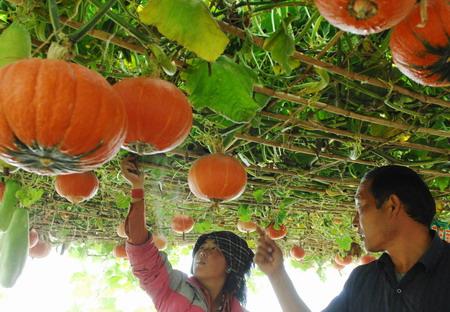
Drolma (left), a farmer in Norbukhyungtse village of Bainang county in Tibet, learns technologies of planting vegetables in a greenhouse from an agricultural expert. [Photo / Xinhua]
XIGAZE, Tibet - Despite the harsh dry climate and clay soil in Southwest China's Tibet autonomous region, it is still possible to grow nice vegetables and sweet fruits in the region.In fact, greenhouse vegetables and fruits are booming in Tibet, bringing fresh and yummy vegetables and fruits to the local people.
"Due to the long period of sunshine and the huge temperature difference between day and night, Tibet has advantages in growing sweeter fruits and more delicious vegetables," Guo Xiangzheng, head of Bainang county, Xigaze prefecture in Tibet, told China Daily on Sunday.
There are about 5,262 greenhouses for vegetable and fruit planting in the county, selling vegetables and fruits to five nearby cities, with a total output of 2,312 tons in 2010, according to local government statistics.
The net income of every greenhouse is estimated to be 7,000 yuan ($1,080), while the total income in 2010 was 41 million yuan.
Nets for shading are put above the plants to prevent excessive sunshine, Guo said, adding that more than 60 kinds of vegetables and fruits have been successfully planted in greenhouses in Bainang.
"Our target is to let the local people eat healthy vegetables and fruits," he said.
In the coming three years, Guo said the county plans to build another 24 greenhouses to promote planting technology and raise the local people's living conditions.
For local people, learning the new technologies brings real benefits.
Yong Jun, a 40-year-old farmer from Zanda county, Ngari prefecture in Tibet, earns more than 20,000 yuan every year from the greenhouse watermelons he plants.
"So far, more than 60 percent of my watermelons have been ordered at the price of 14 yuan a kilogram," Yong smiled. He has seven greenhouses for watermelons and cucumbers.
Seeing Yong's happiness, Li Guian, an agricultural expert from North China's Hebei province who comes to teach the local people how to grow plants in greenhouses, felt all his efforts were worthwhile.
"This year, another 40 greenhouses will be built to meet the increasing demand for fresh vegetables and fruits in the market," he added.
Jamyang Tsering, deputy director of the information and press office of the Ngari prefecture, said that in the past, fruits and vegetables were mainly transported from the Xinjiang Uygur autonomous region, but now Tibetans can eat fruits and vegetables grown in the region.
In 2010, the area of planted vegetables increased to 21,330 hectares, up 290 hectares, according to statistics from the Tibet social development report in 2010.





